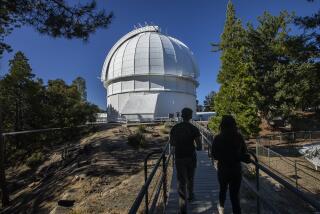Plan for Radiotelescope Generates Excited Buzz Among Astronomers
- Share via
CHARLESTON, W.Va. — George Seielstad stood numbly as he looked at the wreckage of his “one-of-a-kind” radiotelescope set in a valley of the rugged Allegheny Mountains.
The radiotelescope, which is as long as a football field, had collapsed in on itself one cool November night in 1988, the result of metal fatigue after 26 years of searching the heavens from a special “radio quiet zone” about 220 miles west of Washington.
“I was speechless and felt total disbelief. That telescope was one of a kind,” said Seielstad, director of the National Radio Astronomy Observatory at Green Bank.
But the heap of twisted metal has given scientists a stellar opportunity. Plans are under way for a radiotelescope to tower 35 stories above and 330 feet around isolated Deer Creek Valley.
By 1995, the $75-million telescope should be ready to map the undiscovered universe by listening to the radio waves of outer space instead of peering into it.
“We’re making something that will define the state-of-the-art radiotelescope technology to take us well into the next century,” Seielstad said.
Astronomers said the telescope’s technical advancements will open more doors to understanding the evolution of the universe and composition of gases between galaxies. Scientists also can pursue more in-depth studies of pulsars, or small, quick-moving stars.
The first telescope, completed in 1962 for $850,000, detected radio signals from far beyond the Milky Way and helped unlock the secrets to pulsars and quasars.
The new telescope will be designed to receive more and clearer signals with a solid surface of about 2,000 individually controlled panels to counteract the sagging effects of gravity as the telescope moves.
The telescope also will be fully movable, allowing it to point anywhere in the northern sky. The original telescope moved only up and down and relied on the Earth’s rotation for further direction.
“It will be 10 times more sensitive than anything else we have on Earth,” said Ludwig Oster, program manager for the National Science Foundation, which is funding the project. “It will be on the cutting edge of technology and will do research that can’t be done anywhere else. We can look further back in time toward the ‘Big Bang.’ ”
The telescope will be able to pick up naturally emitted radio signals from as far away as 10 billion light-years, giving scientists a glimpse into when galaxies first formed, astronomers said.
The first search for intelligent life was at Green Bank and the new telescope may be included in some occasional extraterrestrial studies, Seielstad said.
Green Bank is in the world’s only radio quiet zone, a 13,000-square-mile area designated by the federal government in 1958.
Local radio and television stations can be picked up by the valley’s 500 residents, but signals are carefully regulated. Many residents have cable television. The mountains of the Monongahela National Forest also shield the instruments from radio “noise” caused by anything from car engines to toasters.
“It makes this a unique spot on Earth and is the equivalent of a national park except we’re protecting radio-frequency space,” Seielstad said.
Jay Lockman, an astronomer at the observatory’s office in Charlottesville, Va., said the advanced telescope and radio quiet zone will make Green Bank a leading facility for astronomers from all over the world.
“The collapse left a major gap, but you have to take events like this and focus on the future and new opportunities,” Seielstad said. “We couldn’t have predicted it would have turned out this well.”






